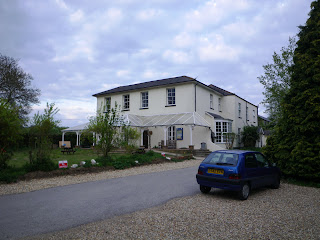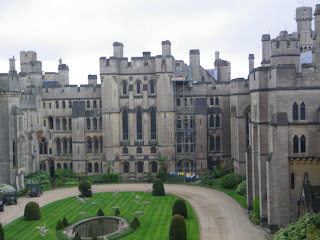The Canadian Military Family Resource Centre tries to bring the children of military members serving throughout the UK together frequently for outings. On Friday we headed out to join the group for a Saturday excursion of Arundel Castle.
This was my first experience staying at a youth hostel and aside from sleeping in a bunk bed 6" off the ground and 2" too short, communal bathrooms and no heat, I must say it was a pleasant experience.
This is the YHA youth hostel in Arundel. It is clean, the food is good, it is licensed to serve alchol, and the prices are extremely reasonable.
Friday evening, to work up an appetite we set off with the kids and our house mother/coordinator Stacey to find a geocache. The roads are very narrow and the cars very fast.
Stacey leading the pack in the hunt.
Jeff was the first to find it but stood back and with broad facial contortions tried to point it out to a couple of the kids. It took them a while with a lot of coaching on Jeff's part, but they found it finally. We had described geocaching to the group and mentioned that many caches had articles that the finders could take away as long as they added something to the cache. I think the idea of buried treasure motivated the group and they were a little disappointed to find that the cache was a small one with only a logbook.
A very early and lonely poppy. The weather was cold and cloudy.
Our destination for tomorrow.
After a very filling and delicious English breakfast we were off for a tour of Weald & Downland Open Air Museum. It is a UK version of Upper Canada Village and since most of ther building predate Canada, I guess I should say Upper Canada Village is the Canadian version of Weald & Downland. What ever way I say it, it was very enjoyable. These little statutes greeted us as we began our tour.
I should have probably made some notes concerning dates and such, but all I did was enjoy the views of the buildings. There are over 50 buildings small and large dating from between the 13th and 19th centuries.
The list of tolls from a cottage on a toll road built in 1807.
A market hall from 1620. Produce was sold on the ground floor, sheltered from the weather. The upper room served as a council chamber and as needed, a court room. The area under the stairs was a lock-up for offenders.
We had a tour guide that had an annoying habit of finishing each sentence with the phrase "all right!"
A pizza oven? Or just a bread oven? No chimneys in these houses, the smoke had to find it's own way out.
A little one-room school house.
During lambing season the sheep could not be left so the shepherds moved these little cabins out to the lambing fields.
Quite cozy.
The kids being introduced to a shire horse.
I don't know if the kids are paying attention to the tour guide or the fire. It was cold!!
Maeghan and Alexander snuck back in for some more warmth.
They had en-suites in the 14th century. Look out below!!
Cooking in a house before the advent of fireplaces and chimneys, dark and smoky.
The kids really enjoyed the simple fare of leeks, cheese and onions wrapped in pastry and 'deep fried'. The pastry was thick enough that it cooked trough but did not brown. We picked up some stone ground flour from the operating water driven mill on the property but have yet to try the recipe mainly because the lard has to be at the boiling point. Not something I would like to try on a stove.
From there we moved on to Arundel Castle. Looks like someone felt they were being ignored.
The 'gang' in front of the impressive castle.
Arundel Castle is the seat of the Dukes of Norfolk, hereditary Earl Marshal of England, an officeholder under Queen Elizabeth.
He and his family live here, in quarters not open to the public. Unfortunately we were not permitted to take any photographs so all I have is photos from the outside of the castle.
Jeff and Maeghan enter the castle.
These photos were taken from the walls of the keep, the oldest and highest part of the castle. The keep dates from about 1190.
The walkway up to the keep.
The chapel in the keep.
The boys inspecting the hole in the wall, i.e. the outdoor plumbing.
Not sure what this would have been used for.
They are trying to find the magic flint nodule that would open the secret door (from a Harry Potter movie).
A very impressive building.
The Earl's garden. Strangely enough most of the ornamentation in the garden was made of wood, such as these urns.
If you look closely on the ground the remains of a maze can be seen. Alexander entered the maze and with a lot of shouting, the rest of the group was able to guide him to the rock circle in the centre. Almost lost him a couple of times.
No one was brave enough to stick their hand in the stream of water to see if it alone was supporting the crown.
Fitzalan Chapel.
"Founded in 1390 by the 4th Earl of Arundel and situated in the grounds of Arundel Castle, the Fitzalan Chapel is still the burial place of the Dukes of Norfolk. It is a fine example of Gothic architecture with a carved timber roof and choir stalls. The carved stone tombs are of major artistic interest. In 1879 it was determined that the Chapel did not form part of the Protestant parish church but was an independent ecclesiastical structure and therefore remains Catholic. A glass wall now divides the Chapel from the parish church; an unusual, if not unique, anomaly in England. Access involves a ramp and a step to the gardens and 9 steps up to the Chapel."
Not too sure what this is, but it lies beneath a casket supported by the decorative pillars.
A few scenes from the town of Arundel. According to two sources, Arundel is a town instead of a city because, although it has a cathedral within the town limits, it is a Roman Catholic cathedral.
The remains of a Blackfriars or Dominican Friary built in the second quarter of the thirteenth century.
Jeff and I drove back to the youth hostel, while Stacy and the kids walked. We turned off before the youth hostel to watch them come across the fields.Unknown to us the decided to follow the road with a stopoff in a store along the way.
We crossed the railway tracks twice before I noticed what I thought was a third rail as there were no overhead wires to supply electricity to the trains. This nation is ultra-conservative in their health and safety issues and yet here is a rail carrying high voltage with no safety devices to prevent some one from touching the rail.
Sunday morning after breakfast and farewells we headed for the coast for a brief sight-seeing trip before heading home.
In Worthing we found a pier to wander on.
The fishing regulations are set up to keep the long fishing poles, some 14 feet or more in length, out of the way of the tourists.
The main tourist attraction, aside from the water, is the gambling machines that are open to children of all ages. There is also a room set aside for over 18 gamblers where the stakes and the payouts increase ten-fold or more.
From Worthing we made our way to the more famous pier at Brighton Pier.
Alexander and Maeghan doing the tourist thing.
The remains of the West Pier that suffered two fires in the spring of 2003.
Legalized child gambling.
We have no idea why there was a Canadian flag flying on the Brighton, or as the locals call it the Palace Pier.
Maeghan and Jeff enjoying the brisk salt air.
A cleverly disguised geocache at the end of the pier. The cache is supposed to be suspended by a string to make it less obvious to muggles (i.e. non-geochachers). We had to wait for a few muggles to take their photographs and move on before we could retrieve the cache.
Our last view of the ocean before we headed home.

































































No comments:
Post a Comment